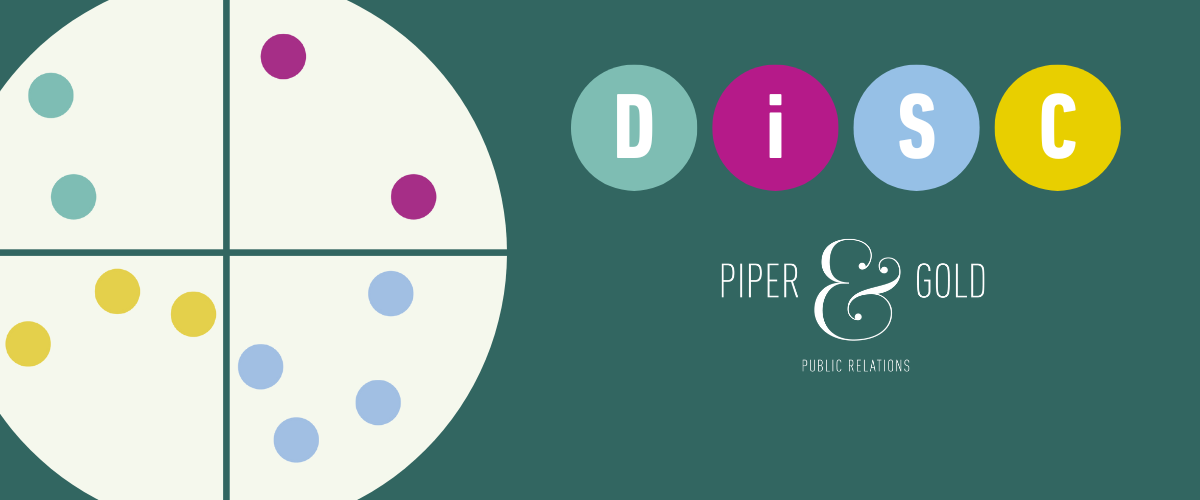
Understanding work styles: Insights from our DiSC workshop with Keith Speers
Sep 25, 2024
Category: P&G culture
This month, our team had an important and informative workshop with Keith Speers, Life & Business Strategist and CEO of Consulting Without Limits. P&G has a long history with Keith — we have been working with him for over 10 years for business consultation, leadership training and strengthening our work styles to attain our goals better.
The workshop was focused on DiSC, an assessment-based learning experience designed by Wiley to “help people work better together.” The acronym DiSC — which stands for dominance, influence, steadiness and conscientiousness — helps you determine your working style, your defaults to interactions, and what type of work environment works best for you. Knowing your preferences — and those of your peers — allows you to create a more effective work environment by understanding and adapting to allow each other to thrive. Below is a visual model of DiSC from Everything DiSC. During our workshop, we discussed how each DiSC style is similar and different from the other. These traits are on a continuum, and you can fall anywhere on it. Most people typically share traits with more than one style. Here’s what we learned about each style — and ourselves:
During our workshop, we discussed how each DiSC style is similar and different from the other. These traits are on a continuum, and you can fall anywhere on it. Most people typically share traits with more than one style. Here’s what we learned about each style — and ourselves:
Dominance (D):
(Kate, Malorie, Lisa, Grace, Ellie, Kayla)
People with a primary ‘D’ style are often goal-oriented. The focus on gaining results drives them in their work. They tend to be more outspoken than others, enjoy voicing their opinions on projects, and often think they are always right (Keith said it, not us!). ‘D’ style people enjoy the challenge of taking on projects and being successful. However, they can be unclear with their expectations of tasks, especially if they assume everyone is thinking the same way they are.
This workshop revealed that many of our team members share traits in the ‘D’ category. We had an insightful conversation about how ‘D’ styles can flex to others' needs by slowing down and stating clear expectations.
Influence (i):
(Lisa, Cassie, Claire, Hilary)
Those with influence styles have a special appreciation and enthusiasm for the workplace. They love collaborating with others to get the job done. People with ‘i’ styles may be outgoing and talkative, able to form relationships with almost everyone. They also are always willing to take action.
But ‘i’ styles can be disorganized at times. They get discouraged when told they’re wrong but not told why. This is where they may bump heads with ‘D’ styles.
Steadiness (S):
(Lauren, Rachel, Cassie, Claire, Zoe, Grace)
Steadiness styles excel when they collaborate with others to create a thorough plan. They like to move slower than others to ensure their work is complete before receiving feedback. Like ‘i’ styles, they want to know the WHY behind the feedback they receive from others. ‘S’ styles want to be able to understand what they did wrong to fix it in the future.
‘S’ styles are afraid of change. They don’t like an unfamiliar environment and they can be indecisive at times. ‘S’ styles also flex to others’ workplace styles more easily to ensure everyone’s voice is heard.
Conscientiousness (C):
(Lauren, Kate, Rachel, Malorie, Kayla, Grace, Ellie)
Conscientiousness styles are very cautious with their work. They want to make sure they’re doing everything exactly right to drive well-rounded results. They may question everything everyone else does and why they do it, but they do it with the right intentions.
Because they are cautious, ‘C’ styles are often too critical and overanalyze so much that it overwhelms them. They’re afraid of being wrong because they take the time to make logical and accurate decisions to get a task right the first time.
How P&G is utilizing DiSC:
The DiSC workshop with Keith allowed our team to deeply think about our individual working styles and hear how our team members thrive in the work environment. We learned the importance of flexing to others' work styles while remembering that it goes both ways. For example, a ‘D’ style setting clear, detailed expectations for an ‘S’ style is considered flexing. When we understand how others work best, we can work proficiently to achieve our desired outcomes.



